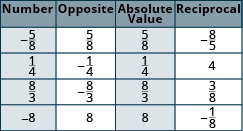| << Chapter < Page | Chapter >> Page > |
Find the reciprocal of each number. Then check that the product of each number and its reciprocal is
To find the reciprocals, we keep the sign and invert the fractions.
| ⓐ | |
| Find the reciprocal of . | The reciprocal of is . |
| Check: | |
| Multiply the number and its reciprocal. | |
| Multiply numerators and denominators. | |
| Simplify. |
| ⓑ | |
| Find the reciprocal of . | |
| Simplify. | |
| Check: | |
| ⓒ | |
| Find the reciprocal of . | |
| Check: | |
| ⓓ | |
| Find the reciprocal of . | |
| Write as a fraction. | |
| Write the reciprocal of . | |
| Check: | |
In a previous chapter, we worked with opposites and absolute values. [link] compares opposites, absolute values, and reciprocals.
| Opposite | Absolute Value | Reciprocal |
|---|---|---|
| has opposite sign | is never negative | has same sign, fraction inverts |
Fill in the chart for each fraction in the left column:
| Number | Opposite | Absolute Value | Reciprocal |
|---|---|---|---|
To find the opposite, change the sign. To find the absolute value, leave the positive numbers the same, but take the opposite of the negative numbers. To find the reciprocal, keep the sign the same and invert the fraction.
| Number | Opposite | Absolute Value | Reciprocal |
|---|---|---|---|
Fill in the chart for each number given:
| Number | Opposite | Absolute Value | Reciprocal |
|---|---|---|---|

Fill in the chart for each number given:
| Number | Opposite | Absolute Value | Reciprocal |
|---|---|---|---|
Why is We previously modeled this with counters. How many groups of counters can be made from a group of counters?

There are groups of counters. In other words, there are four in So,
What about dividing fractions? Suppose we want to find the quotient: We need to figure out how many there are in We can use fraction tiles to model this division. We start by lining up the half and sixth fraction tiles as shown in [link] . Notice, there are three tiles in so

Model:
We want to determine how many are in Start with one tile. Line up tiles underneath the tile.

There are two in
So,
Model:
We are trying to determine how many there are in We can model this as shown.

Because there are eight in
Let’s use money to model in another way. We often read as a ‘quarter’, and we know that a quarter is one-fourth of a dollar as shown in [link] . So we can think of as, “How many quarters are there in two dollars?” One dollar is quarters, so dollars would be quarters. So again,

Using fraction tiles, we showed that Notice that also. How are and related? They are reciprocals. This leads us to the procedure for fraction division.
If are numbers where then
To divide fractions, multiply the first fraction by the reciprocal of the second.

Notification Switch
Would you like to follow the 'Prealgebra' conversation and receive update notifications?